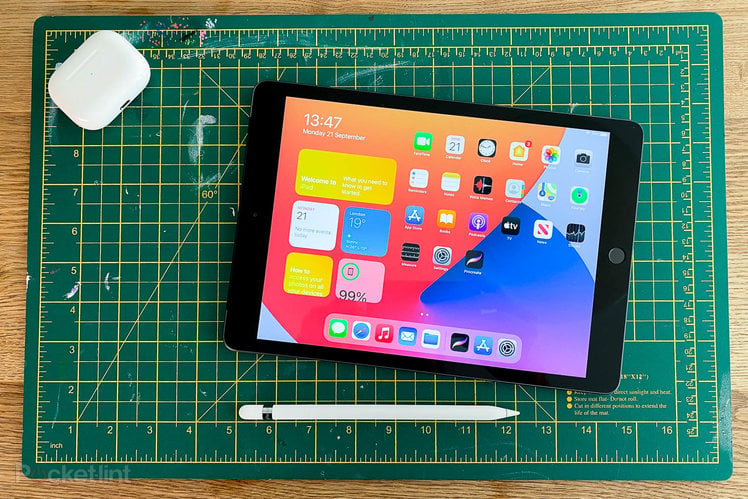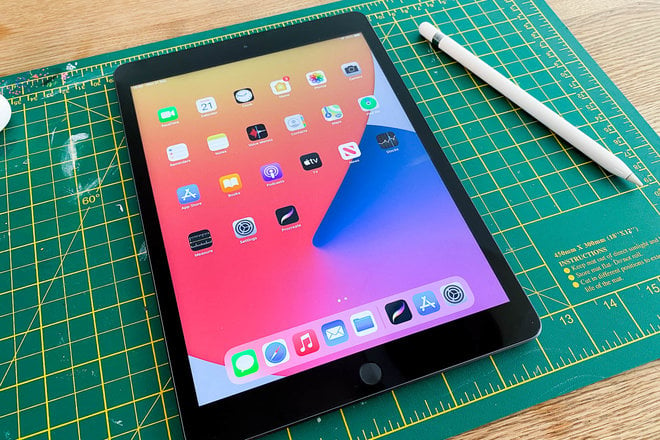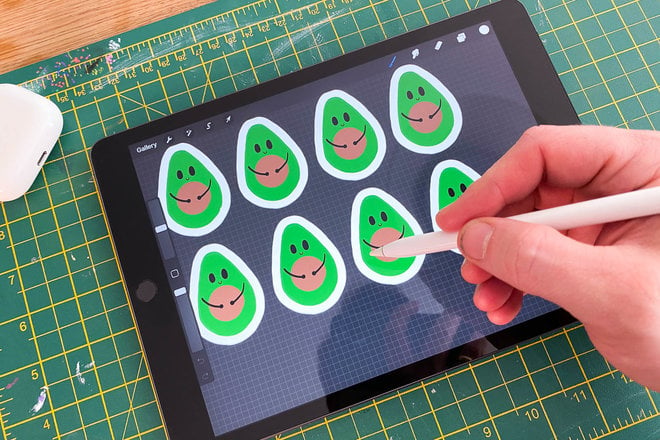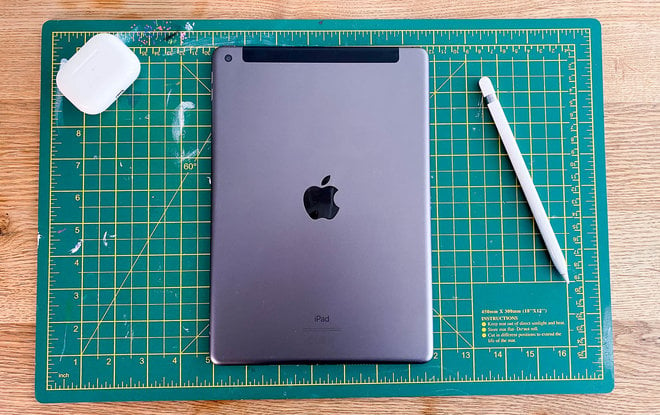
Apple announced two iPads at its annual September event: the high-spec iPad Air, and this, the more affordable iPad – which, for 2020 and more than a decade after the original launched, is now in its eight generation.
The iPad Air takes its design lead from the iPad Pro range, with a new thinner design, reduced bezel, and removal of the Home button. The 2020 iPad 8th Gen, however, gets none of that – instead sticking to the same design as showcased in 2019 on the 7th Gen model.
So, with a similar design language that’s been present on the iPad for the last decade, should that mean that you instantly rule out getting the new entry-level iPad?
Design
- 10.2-inch Retina Display, 2160 x 1620 resolution (264ppi)
- Size & Weight: 250.6 x 174.1 x 7.5mm / 483g
- Touch ID fingerprint sensor Home button
- Made with 100% recycled aluminium
- Finishes: Silver, Space Grey, Gold
The design is effectively the same as the 2019 model. That means the 8th Gen iPad keeps the 10.2-inch Retina display, the same Home Button with TouchID (that iPad users who’ve not “gone Pro” will know how to use), and the same Lightning port to charge.
The smart connectors that were introduced in 2019 are present, too, meaning you can connect a smart keyboard – that’s optional, of course – and there’s support for the first-gen Apple Pencil too.

The design is therefore looking a bit tired compared to the iPad Pro and the new iPad Air. It’s not exactly exciting in terms of what’s possible, but then its priced accordingly too.
Disappointingly Apple hasn’t used the new release to add anything in terms of screen tech. It still doesn’t come with Apple’s True Tone technology – which adjusts the white balance based on ambient lighting conditions – as found on other iPads. It’s still just as reflective as the 2019 model because there’s no anti-reflective coating on the screen, which will affect viewing if you’re planning on using the iPad outside.
Power & Performance
- A12 Bionic processor
- 32GB and 128GB storage sizes
- 8-megapixel camera on rear, FaceTime HD camera on front
- Connectivity: Wi-Fi 802.11a/b/g/n/ac / Wi-Fi + Cellular model offers 4G
So, if nothing has changed with the design, what has changed? Apple has swapped out the A10 processor used in the 2019 model and replaced it with the A12 Bionic. That’s the same processor found in the iPhone XR, iPhone XS, and the 2019 iPad Air if you’re wondering.
Considering who this iPad is aimed at – sofa surfers, casual gamers, and TV streamers – the processor is more than capable of delivering what you need. Don’t think for a moment that it can’t do anything other than basic tasks. We’ve been able to happily enjoy editing a movie in iMovie, churning through some picture editing, and playing some power-hungry games.

How long does the battery last? It always comes down to how you use it.
Fire up a Zoom chat, do some chatting on Skype, talk to your teammates on Slack, or give it to the kids to play Roblox, and you’ll see that battery drain pretty fast. Stick to web browsing, watching Netflix, and maybe some drawing using the optional Apple Pencil and you’ll get a good 10 hours – which for most will mean the need to only charge it weekly.
There’s a camera – it’s the same as the 2019 model, unsurprisingly – and that’s about as much as you’ll care about it. As we said in our review for the 2019 iPad Air model: “The results are good enough, and you won’t struggle in those rare moments when you need to capture that mega awesome thing your kid is doing, and all you have to hand is an iPad.” The same can be said about the 2020 iPad ‘s camera capabilities.
If you want power without going Pro, then you’ll need to opt for the considerably more expensive (well compared to this model) 2020 iPad Air with its A14 Bionic chip, up to 256GB storage options, support for the second-gen Apple Pencil and Magic Keyboard, and a slightly bigger 10.9-inch screen.
iPadOS 14
- Scribble hand-writing technology
- New phone/video call alerts
- Improved search feature
While iPadOS 14 isn’t exclusive to the 2020 iPad 8th Gen model, it does bring a number of features that change the use of the device for the better.
The main one is Scribble. Used in conjunction with the Apple Pencil you can now pretty much write as if it was a paper notepad. Those “scribbles” can then be turned into legible copy that the iPad can understand.

Whether that’s jotting down some thoughts in Notes or writing an email in Mail, the system works really well and means that you could effectively ditch the need for a keyboard if you want.
That’s the big change. There are other changes of course, like a new Mac-like search feature, design tweaks to how apps display themselves, and the much called for change to phone/video call alerts now not taking over the entire screen.
iPadOS does get some limited widget support (in comparison to iOS 14), but you don’t get the App Library functionality.
